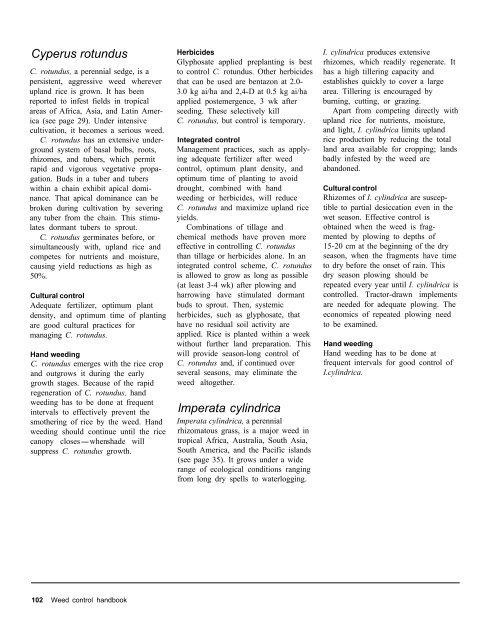A handbbok on Weed Control in Rice.pdf
A handbbok on Weed Control in Rice.pdf
A handbbok on Weed Control in Rice.pdf
You also want an ePaper? Increase the reach of your titles
YUMPU automatically turns print PDFs into web optimized ePapers that Google loves.
Cyperus rotundus<br />
C. rotundus, a perennial sedge, is a<br />
persistent, aggressive weed wherever<br />
upland rice is grown. It has been<br />
reported to <strong>in</strong>fest fields <strong>in</strong> tropical<br />
areas of Africa, Asia, and Lat<strong>in</strong> Amer-<br />
ica (see page 29). Under <strong>in</strong>tensive<br />
cultivati<strong>on</strong>, it becomes a serious weed.<br />
C. rotundus has an extensive under-<br />
ground system of basal bulbs, roots,<br />
rhizomes, and tubers, which permit<br />
rapid and vigorous vegetative propa-<br />
gati<strong>on</strong>. Buds <strong>in</strong> a tuber and tubers<br />
with<strong>in</strong> a cha<strong>in</strong> exhibit apical domi-<br />
nance. That apical dom<strong>in</strong>ance can be<br />
broken dur<strong>in</strong>g cultivati<strong>on</strong> by sever<strong>in</strong>g<br />
any tuber from the cha<strong>in</strong>. This stimu-<br />
lates dormant tubers to sprout.<br />
C. rotundus germ<strong>in</strong>ates before, or<br />
simultaneously with, upland rice and<br />
competes for nutrients and moisture,<br />
caus<strong>in</strong>g yield reducti<strong>on</strong>s as high as<br />
50%.<br />
Cultural c<strong>on</strong>trol<br />
Adequate fertilizer, optimum plant<br />
density, and optimum time of plant<strong>in</strong>g<br />
are good cultural practices for<br />
manag<strong>in</strong>g C. rotundus.<br />
Hand weed<strong>in</strong>g<br />
C. rotundus emerges with the rice crop<br />
and outgrows it dur<strong>in</strong>g the early<br />
growth stages. Because of the rapid<br />
regenerati<strong>on</strong> of C. rotundus, hand<br />
weed<strong>in</strong>g has to be d<strong>on</strong>e at frequent<br />
<strong>in</strong>tervals to effectively prevent the<br />
smother<strong>in</strong>g of rice by the weed. Hand<br />
weed<strong>in</strong>g should c<strong>on</strong>t<strong>in</strong>ue until the rice<br />
canopy closes-when shade will<br />
suppress C. rotundus growth.<br />
102 <strong>Weed</strong> c<strong>on</strong>trol handbook<br />
Herbicides<br />
Glyphosate applied preplant<strong>in</strong>g is best<br />
to c<strong>on</strong>trol C. rotundus. Other herbicides<br />
that can be used are bentaz<strong>on</strong> at 2.0-<br />
3.0 kg ai/ha and 2,4-D at 0.5 kg ai/ha<br />
applied postemergence, 3 wk after<br />
seed<strong>in</strong>g. These selectively kill<br />
C. rotundus, but c<strong>on</strong>trol is temporary.<br />
Integrated c<strong>on</strong>trol<br />
Management practices, such as apply-<br />
<strong>in</strong>g adequate fertilizer after weed<br />
c<strong>on</strong>trol, optimum plant density, and<br />
optimum time of plant<strong>in</strong>g to avoid<br />
drought, comb<strong>in</strong>ed with hand<br />
weed<strong>in</strong>g or herbicides, will reduce<br />
C. rotundus and maximize upland rice<br />
yields.<br />
Comb<strong>in</strong>ati<strong>on</strong>s of tillage and<br />
chemical methods have proven more<br />
effective <strong>in</strong> c<strong>on</strong>troll<strong>in</strong>g C. rotundus<br />
than tillage or herbicides al<strong>on</strong>e. In an<br />
<strong>in</strong>tegrated c<strong>on</strong>trol scheme, C. rotundus<br />
is allowed to grow as l<strong>on</strong>g as possible<br />
(at least 3-4 wk) after plow<strong>in</strong>g and<br />
harrow<strong>in</strong>g have stimulated dormant<br />
buds to sprout. Then, systemic<br />
herbicides, such as glyphosate, that<br />
have no residual soil activity are<br />
applied. <strong>Rice</strong> is planted with<strong>in</strong> a week<br />
without further land preparati<strong>on</strong>. This<br />
will provide seas<strong>on</strong>-l<strong>on</strong>g c<strong>on</strong>trol of<br />
C. rotundus and, if c<strong>on</strong>t<strong>in</strong>ued over<br />
several seas<strong>on</strong>s, may elim<strong>in</strong>ate the<br />
weed altogether.<br />
lmperata cyl<strong>in</strong>drica<br />
Imperata cyl<strong>in</strong>drica, a perennial<br />
rhizomatous grass, is a major weed <strong>in</strong><br />
tropical Africa, Australia, South Asia,<br />
South America, and the Pacific islands<br />
(see page 35). It grows under a wide<br />
range of ecological c<strong>on</strong>diti<strong>on</strong>s rang<strong>in</strong>g<br />
from l<strong>on</strong>g dry spells to waterlogg<strong>in</strong>g.<br />
I. cyl<strong>in</strong>drica produces extensive<br />
rhizomes, which readily regenerate. It<br />
has a high tiller<strong>in</strong>g capacity and<br />
establishes quickly to cover a large<br />
area. Tiller<strong>in</strong>g is encouraged by<br />
burn<strong>in</strong>g, cutt<strong>in</strong>g, or graz<strong>in</strong>g.<br />
Apart from compet<strong>in</strong>g directly with<br />
upland rice for nutrients, moisture,<br />
and light, I. cyl<strong>in</strong>drica limits upland<br />
rice producti<strong>on</strong> by reduc<strong>in</strong>g the total<br />
land area available for cropp<strong>in</strong>g; lands<br />
badly <strong>in</strong>fested by the weed are<br />
aband<strong>on</strong>ed.<br />
Cultural c<strong>on</strong>trol<br />
Rhizomes of I. cyl<strong>in</strong>drica are suscep-<br />
tible to partial desiccati<strong>on</strong> even <strong>in</strong> the<br />
wet seas<strong>on</strong>. Effective c<strong>on</strong>trol is<br />
obta<strong>in</strong>ed when the weed is frag-<br />
mented by plow<strong>in</strong>g to depths of<br />
15-20 cm at the beg<strong>in</strong>n<strong>in</strong>g of the dry<br />
seas<strong>on</strong>, when the fragments have time<br />
to dry before the <strong>on</strong>set of ra<strong>in</strong>. This<br />
dry seas<strong>on</strong> plow<strong>in</strong>g should be<br />
repeated every year until I. cyl<strong>in</strong>drica is<br />
c<strong>on</strong>trolled. Tractor-drawn implements<br />
are needed for adequate plow<strong>in</strong>g. The<br />
ec<strong>on</strong>omics of repeated plow<strong>in</strong>g need<br />
to be exam<strong>in</strong>ed.<br />
Hand weed<strong>in</strong>g<br />
Hand weed<strong>in</strong>g has to be d<strong>on</strong>e at<br />
frequent <strong>in</strong>tervals for good c<strong>on</strong>trol of<br />
I. cyl<strong>in</strong>drica.











